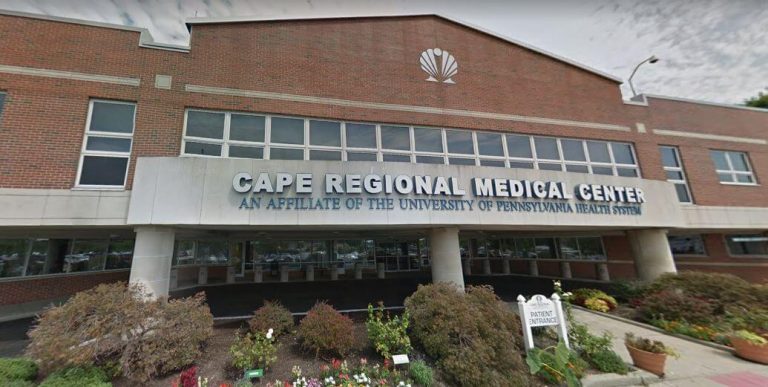ERMA – If the final hurdle involving Superior Court approval is cleared as expected, the closing on the merger of Cape Regional Health System and Cooper University Health System could occur by June 1.
That was the message from Joanne Carrocino, Cape Regional’s president and CEO, when she addressed members of the community at a Tabernacle United Methodist Church event on Saturday, April 27.

Carrocino and Tom Piratzky, executive director of the Cape Regional Foundation, spoke to the group about the status of the pending merger of Cooper and Cape Regional. The merger plans have spent more than a year in regulatory review, gaining the approval of the New Jersey Department of Health and the Office of the Attorney General.
What’s needed next is approval from Superior Court, with Carrocino saying she expects the merger to be on the docket in the next couple of weeks. A June 1 closing would give birth to Cooper University Hospital Cape Regional, a long new name, but one Carrocino said allowed the incorporation of “two strong brands.”
Changes in the national health care environment have presented significant challenges to small, independent acute-care hospital systems. Those challenges already existed when the county was confronted with the Covid pandemic.
Piratzky put it bluntly: “Covid changed health care.” The pandemic put financial pressure on independent health systems while also draining the national system of physicians and other health-care providers. An emerging shortage of providers mushroomed as the pandemic led many to leave the field.
Carrocino said the impact of Covid, particularly on staffing, and the need to make a major investment in an integrated computer system led the Cape Regional board of trustees to conclude it was the best time “to choose a partner.” The struggle to deliver high-quality health care as an independent system was only going to get more difficult.
She made it clear that it was a Cape Regional decision to seek a larger system with which to partner. This was no shotgun wedding; “we chose Cooper,” she said.
What made Cooper the best fit over other potential partners, including the University of Pennsylvania Health System, came down to several major factors.
Carrocino spoke of the long-standing relationship that Cape Regional already had with Cooper by virtue of the fact that Cooper has supplied Cape Regional with fellowship-trained intensive care physicians for seven years. Cooper’s hospital and trauma center are also the number one choice of Cape Regional patients who must be transferred for more specialized care.
Where patients requiring a transfer go is a patient decision, Carrocino said, and “over 70% of our patients elected to go to Cooper.”
That Cooper University Health System is an academic, teaching system also played a role in the merger decision. “Physician recruitment is a major challenge for us,” Carrocino said. With medical students along with residents and fellows working on advanced training, Cooper offers a pipeline to aid in recruitment to Cape May County that could not be matched by Cape Regional, she said.
The 10-year affiliation of Cooper with M.D. Anderson Cancer Center at the University of Texas in Houston was a big draw. The goal for Cape Regional was a partner that could provide specialty cancer care in the county so patients would not have to travel. Details to follow, Carrocino effectively said, since the first steps in bringing M.D. Anderson to the county involve an analysis in terms of existing capabilities compared with Anderson standards. That analysis begins this summer, and an action plan will follow.
Carrocino also focused on the much-needed replacement of Cape Regional’s computer systems, some of which are sunsetting this year. Part of the agreement with Cooper includes a $25 million installation of a state-of-the-art integrated information system, EPIC, a cloud-based system that will handle functions related to patient records, billing and even clinic care provided at remote locations.
Its importance includes the ability of records to be shared among departments and providers at both Cooper and Cape Regional. It is also, Carrocino said, the leading system at academic health centers, which eases the burden of sharing records in locations outside the Cooper-Cape Regional system, something that could benefit potential patients who own second residences in the county but have permanent homes elsewhere.
The last major reason cited by Carrocino was the commitment of Cooper to growth and expansion, which bodes well for bringing new kinds of care to Cape May County. Considering Cooper Health System at $2 billion in annual revenue compared with Cape Regional at $200 million gives a sense of the new resources that the county may benefit from.
Carrocino spoke of access to more specialized care both through rotating specialist providers who may visit the county on a weekly or monthly schedule and access to telehealth capabilities. The big draw for her would be reducing or eliminating the county provider shortage, especially with general practitioners.
She said that 80% of physicians are now employees of health-care systems rather than independent practitioners “who have put out their shingle.”
Asked if the merger would mean the return of maternity services to the county, Carrocino said there are no plans to reintroduce such services. She pointed again to the doctor shortage, especially with OB/GYN physicians. She said the political environment nationally has increased the potential liability of OB/GYN practitioners to the point where many have resorted to practice in another specialty. She said Cape Regional was still committed to family planning services in the county.

Piratzky added that the county birthrate is too low to provide the dollars necessary for a successful OB/GYN practice. He pointed to the cost of home ownership in Cape May, saying young families cannot afford to live here.
Even if they work here, he said, their homes are in another county, and that county provides their hospital care. He added that the hospital used to handle 500 to 600 births a year, and that number was down to 250 when maternity services were cut.
Cape Regional was not idle while waiting for a merger partner to be identified and the regulatory process to be completed. Piratzky talked about very successful fundraising campaigns that have allowed Cape Regional to expand services.
Two areas of particular note, he said, are the radiology department expansion and the enlargement of the emergency department. Piratzky also highlighted the new Claire C. Brodesser Surgery Center, renovated patient rooms, upgrades to the intensive care unit and plans for a satellite radiology capability in the emergency department.
With Covid front and center as a factor that sped up the need for a merger, Piratzky cited the nine new patient units that will be part of the emergency department expansion and that would play a key role should the county experience another serious contagious disease outbreak.
Contact the reporter, Vince Conti, at vconti@cmcherald.com.









